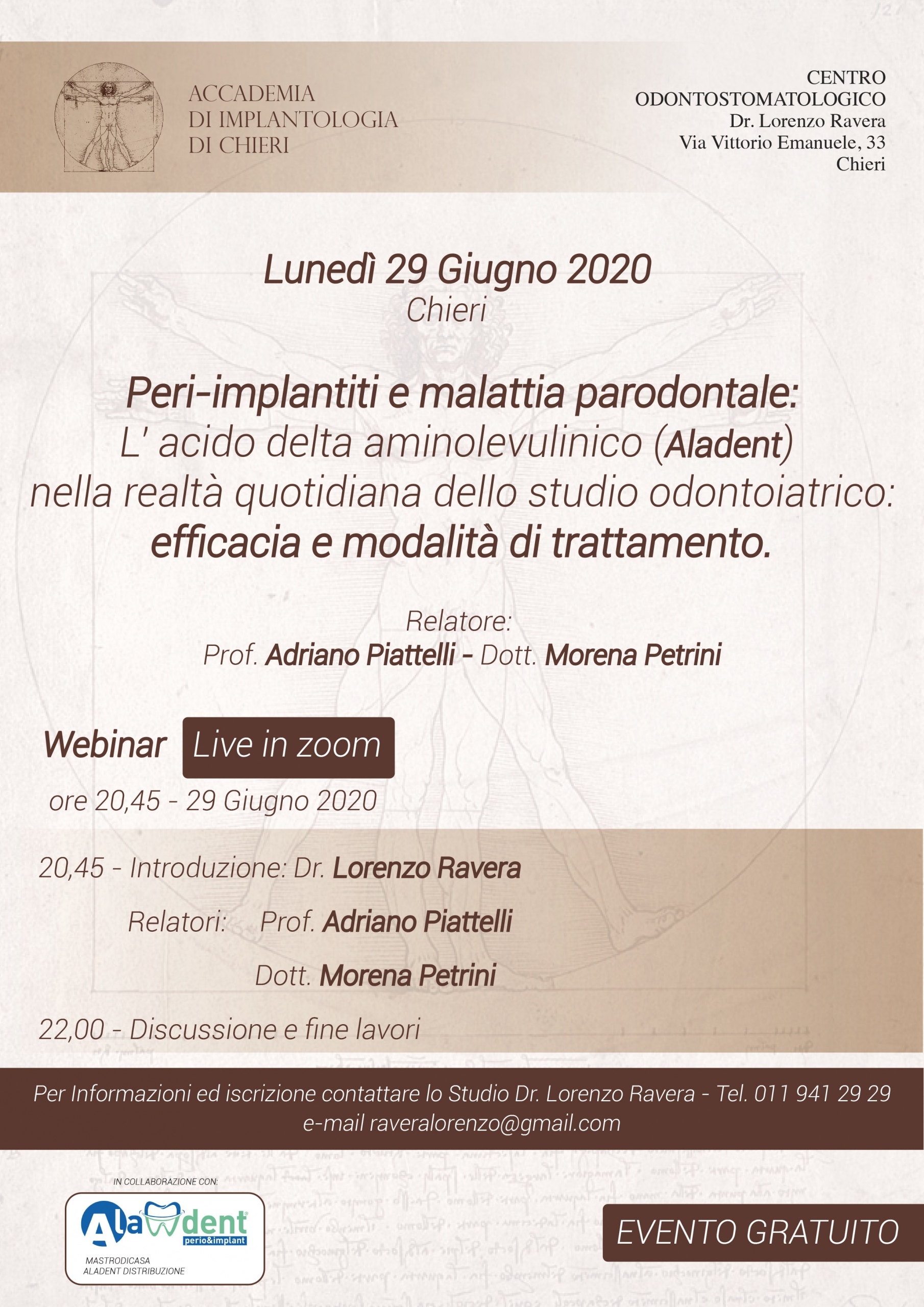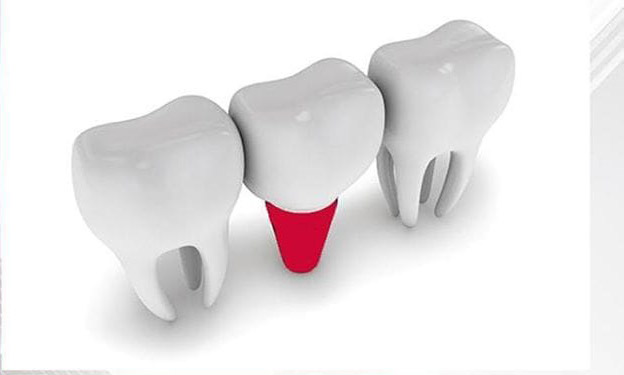Perché è necessario misurare l’ozono nell’ambiente di lavoro durante e dopo la sanitizzazione
/in News /da q82rrfo3L’uso dell’ozono per sanitizzare gli ambienti medici è sempre più diffuso.
È tuttavia necessario avere la certezza che la quantità di gas immessa nell’ambiente sia quella efficace. Inoltre l’ozono è un gas che presenta un certo livello di tossicità per cui, una volta terminata la sanitizzazione, è consigliabile controllarne l’eventuale presenza nell’ambiente con il misuratore per ozono 03- Sense di Alpha strumenti.
03-Sense memorizza e documenta le misure effettuate.
Effects of a novel gel containing 5-aminolevulinic acid and red LED against bacteria involved in peri-implantitis and other oral infections
/in News /da q82rrfo3Antibiotic resistance is a major public health problem worldwide and the finding of alternative methods for eliminating bacteria is one of the prerogatives of medical research. The indiscriminate use of antibiotics in dentistry, especially for the treatment of peri-implantitis, could lead to superinfections.
Alternative methods, like photodynamic therapy mediated by the use of aminolevulinic acid and a red light has been largely described, especially in dentistry, but results were encouraging against Gram-positive bacteria, but limited against Gram-negative.
The effectiveness of photodynamic therapy mediated by a novel product containing aminolevulinic acid, Aladent (ALAD) has been tested in this in vitro study, against different types of bacteria particularly involved in the infections of the oral cavity and peri-implantitis. The novelty of ALAD is the marked hydrophilicity that should increase the passage of the molecule through the membrane pores of Gram-negative bacteria.
Considering the novelty of the product a preliminary experiment permitted to test the effectiveness against Enterococcus faecalis after 1 h of ALAD incubation at different concentrations, with or without different timings of LED irradiation. The count of CFUs and the live/dead observation with fluorescent microscopy showed a significant reduction and killing of bacterium.
Then, in the second stage, that could meet the necessity of effectiveness and the clinician’s requests to reduce the timing of treatment, ALAD, with and without irradiation, was tested on Staphylococcus aureus, Enterococcus faecalis, Escherichia coli, Veillonella parvula and Porphyromonas gingivalis.
In particular, the efficiency of different concentrations of the product after a 25 min incubation was tested with and without the adjunctive LED irradiation for 5 min.
A slight ALAD bactericidal effect was reported for all bacteria, also without LED irradiation, however, the most effective treatment was 25 min of 50% ALAD incubation followed by 5 min of a red LED.
The in vitro tests demonstrated that ALAD gel with LED irradiation exerts a potent antibacterial activity on different bacteria, both Gram-positive and Gram-negative.
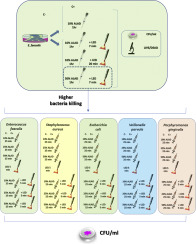
Authors. M.Radunović M.Petrini T.Vlajic G.Iezzi S.Di Lodovico A.Piattelli S.D’Ercole
Peri-implantiti, batteri e impianti – L’uso dell’Acido Delta-aminolevunilico (ALADENT) nella terapia delle malattie parodontali
/in News /da q82rrfo3
Peri-implantiti e malattia parodontale: L’ acido delta aminolevulinico (Aladent) nella realtà quotidiana dello studio odontoiatrico
/in News /da q82rrfo3Peri-implantiti e malattia parodontale:
L’ acido delta aminolevulinico (Aladent)
nella realtà quotidiana dello studio odontoiatrico:
efficacia e modalità di trattamento.
Lunedì 2 Marzo 2020

Convegno 26 Febbraio 2020 – L’acido delta-aminolevulinico (ALADENT) nel trattamento della malattia paradontale e delle peri-implantiti
/in News /da q82rrfo3CONVEGNO
PERI-IMPLANTITI, BATTERI ED IMPIANTI
THINKING OUT OF THE BOX:L’ACIDO DELTA-AMINOLEVULINICO NEL TRATTAMENTO DELLA MALATTIA PARADONTALE E DELLE PERI-IMPLANTITI.
L’ACIDO DELTA-AMINOLEVULINICO (ALADENT) NELLA REALTÀ QUOTIDIANA DELLO STUDIO ODONTOIATRICO.

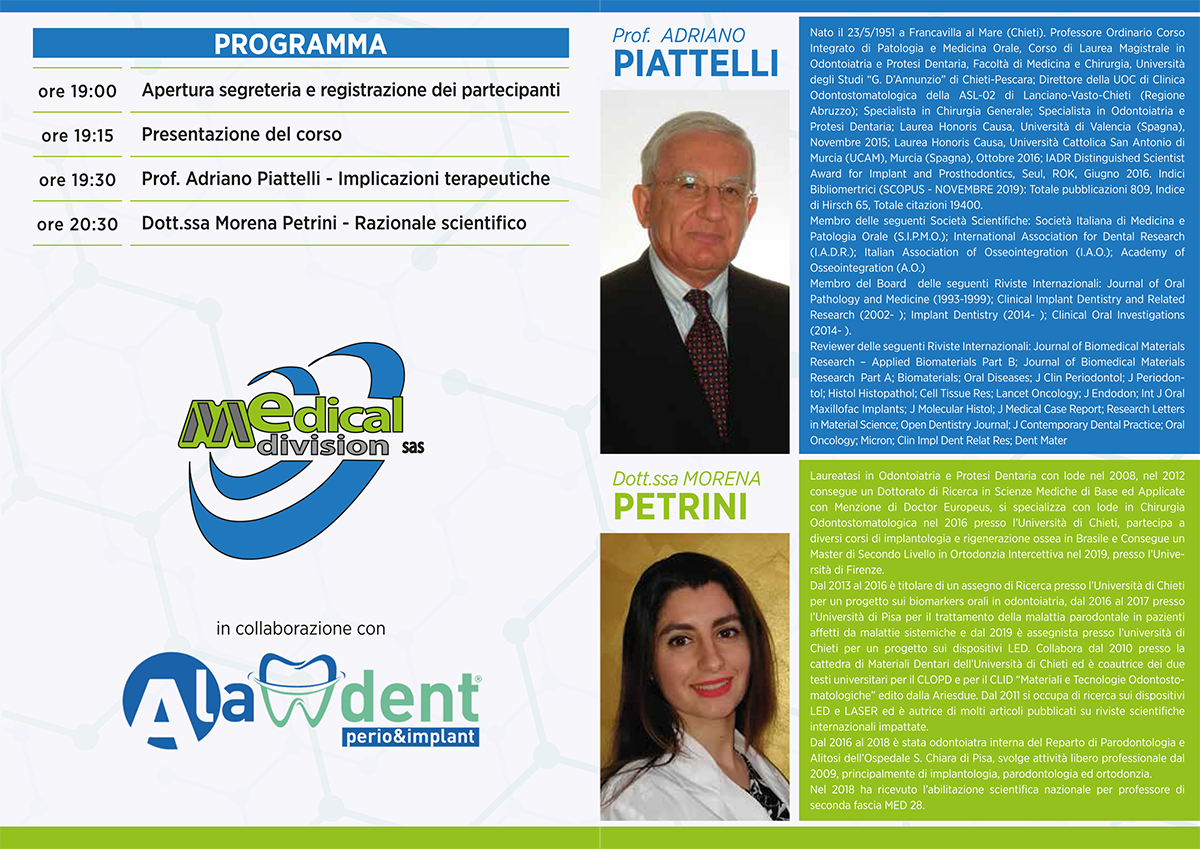
Trattamento perimplantite. Risultati sorprendenti usando l’acido delta-aminolevulinico
/in News /da q82rrfo3Trattamento perimplantite.
Risultati sorprendenti usando l’acido delta-aminolevulinico
(ALADENT)
Unisociesc Florianópolis Ilha – Florianópolis, SC
04 Maggio 2020, 09h-19h30
L’evento è dedicato ai risultati del trattamento perimplantite e all’uso dell’acido delta-aminolevulinico, con approfondimenti circa le ricerche più recenti e le terapie più innovative.

Prof. Adriano Piattelli, MD, DDS, DrHC, DrHC
Professore di patologia e medicina orale
Curriculum breve:
Professore del Dipartimento di Scienze Mediche, Bucais e Biotecnologie dell’Università dell’Andalusia, Chieti-Pescara, Italia;
Professore di Engenharia de Biomateriais da UCAM, Università Cattolica di Múrcia, Múrcia, Espanha;
Grau Honoris Causa, Università di Valencia, Spagna. 23 novembre 2015
Grau Honoris Causa, Università Cattolica di Murcia (UCAM), Murcia, Spagna. 11 ottobre 2016
IADR Destinto Scientist nel 2016, Premio per impianti e protesi, Seoul, (Corea). 22 giugno 2016
Numero totale di articoli pubblicati: 806 (SCOPUS)
Numero totale di appuntamenti: 18.893 (SCOPUS)
Indice di Hirsch: 68 (SCOPUS)
Numero totale di appuntamenti: 26.162 (GOOGLE SCHOLAR)
Indice di Hirsch: 75 (GOOGLE SCHOLAR)
Membro do Conselho scienziato:
Journal of Oral Pathology and Medicine (1993-1999)
Odontoiatria per impianti clinici e ricerca correlata (2002-annuale)
Implant Dentistry (2014-annuale)
Indagini orali cliniche (annuale 2014)
Profa. Dr. Morena Petrini DDS, Ph.D
DENTISTA, PH. D, SPECIALISTA DI CHIRURGIA ORALE, MASTER DI 2 LIVELLI IN ORTODONZIA
• ABILITAZIONE SCIENTIFICA NAZIONALE ITALIANA (ASN) PER IL PROFESSORE ASSOCIATO IN
SCIENZE ODONTOSTOMATOLOGICHE
Date: dal 03-30-2018 al 03-30-2024
• 2 MASTER DI LIVELLO IN ORTODONZIA INTERCETTIVA:
Anni accademici: 2017-2018; Gennaio 2018-febbraio 2019
Nome e tipo di organizzazione che fornisce istruzione e formazione: Università di Firenze
• Corso teorico-pratico in Chirurgia parodontale
Nome e tipo di organizzazione che fornisce istruzione e formazione: Periocampus – Pisa;
Insegnanti: Prof Filippo Graziani, Dott. Francesco Cairo, Dott. Cristiano Tomasi
Ottobre 2016
• SPECIALITÀ DI CHIRURGIA ORALE:
Anni accademici: febbraio 2013- febbraio 2016
Nome e tipo di organizzazione che fornisce istruzione e formazione: Università G. D’Annunzio di Chieti-Italia;
Titolo della tesi: Effetto della terapia laser di basso livello pre-operatoria su dolore, gonfiore e trisma
associato alla chirurgia del terzo molare
Supervisore: Prof Giorgio Perfetti
• Certificato “Imersao em implantodontia com rigeneracao ossea”
Corso clinico avanzato di implantologia e rigenerazione
Nome e tipo di organizzazione che fornisce istruzione e formazione: DB Europe, Implacil DeBortoli, Vila Velha, Brasile;
Tutor: Prof Antonio Scarano
Febbraio 2016
• MEDICO DI FILOSOFIA PH.D CON MENZIONE “MEDICO EUROPEO”
Settore: Scienze mediche di base e applicate: scienza odontostomatologica
Titolo della tesi: Materiali biomimetici in odontoiatria restaurativa
(progetto di ricerca in collaborazione con l’Università di Bristol – gruppo di ingegneria dei biomateriali
(bioMEG) guidato dal dott. Bo Su)
Anni accademici: 2010-2012
Supervisore: Prof. Giuseppe Spoto, Professore ordinario di materiali dentali
Nome e tipo di organizzazione che fornisce istruzione e formazione: Università G. D’Annunzio di Chieti
(Italia)
• CORSO TEORICO E PRATICO IN ORTODONZIA CLINICA “FILO DRITTO IN CORSO”
Date: gennaio 2010- dicembre 2010
Nome e tipo di organizzazione che fornisce istruzione e formazione: Cenacolo Odontostomatologico
dell’Adriatico (COI-AIOG) – Italia
Insegnanti: Prof Daniel Celli
• LAUREA IN DENTISTRY, 110/110 CUM LAUDE
Titolo della tesi: Analisi microbiologiche di titanio e viti di guarigione nitrurate
Supervisore: Prof. Maurizio Piattelli, Professore ordinario di Odontostomatologia
Nome e tipo di organizzazione che fornisce istruzione e formazione: Università G. D’Annunzio di Chieti
(Italia)
Coautori di numerosi articoli scientifici e libri dentali.
Relatore in congressi nazionali e internazionali;
20° Congresso Internazionale A.I.S.I.
/in News /da q82rrfo320° Congresso Internazionale A.I.S.I.
Il Congresso del Ventennale
Sopravvivenza implantare nel terzo millennio: esperienze condivise.
Bologna – Hotel Europa – Via Boldrini, 11
6 e 7 marzo 2020
Aladent sarà presente nello stand di: “Ditta Facchini-Milano”.
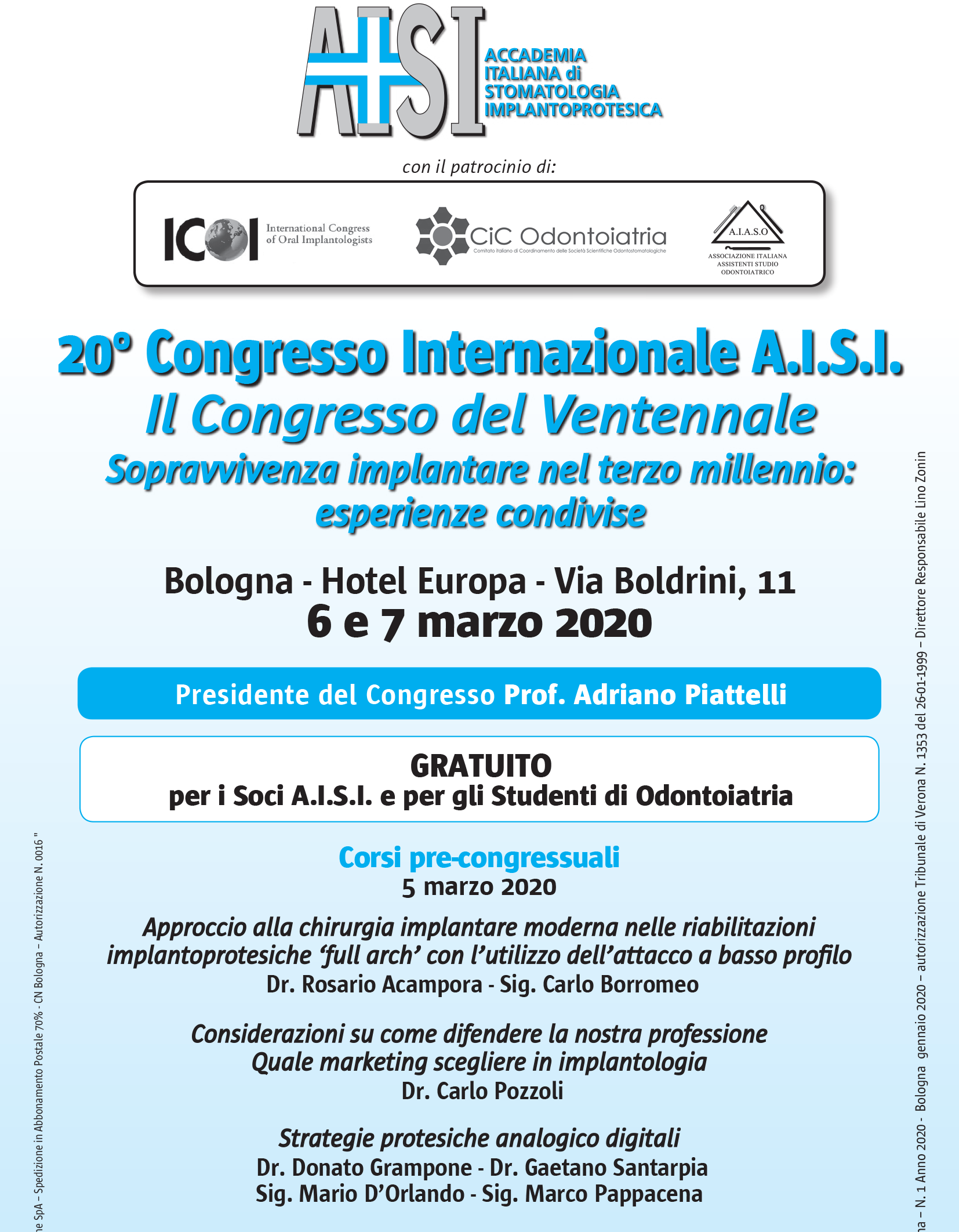
Giornata di aggiornamento per igienisti dentali – Roma 8 Febbraio
/in News /da q82rrfo3AGGIORNAMENTO PER IGIENISTI DENTALI
Roma, sabato 8 febbraio
Giornata di aggiornamento per igieniste dentali.
Applicazioni fotodinamiche relatore ing. G.Villa. Direttore scientifico A.Strumenti.
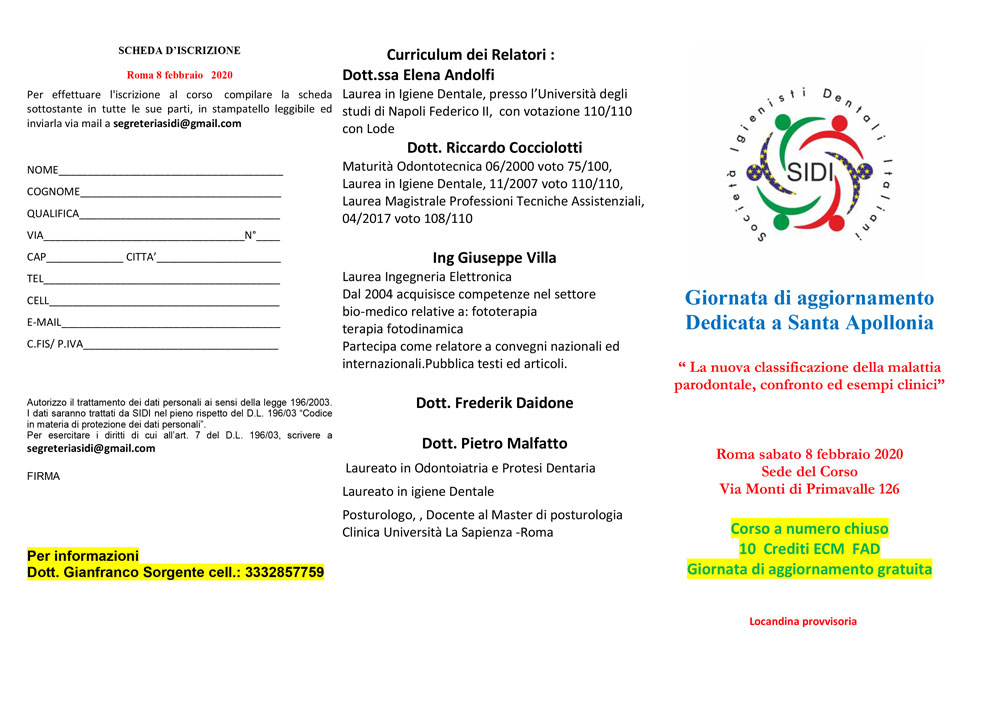

Newly formulated 5% 5-aminolevulinic acid photodynamic therapy on Candida albicans
/in News /da q82rrfo3Giuseppe Greco, Simone Di Piazza, Jiemei Chan, Mirca Zotti, Reem Hanna, Ezio Gheno, Angelina O. Zeckiy, Claudio Pasquale, Nicola De Angelis, Andrea Amaroli.
Highlights
- • Candida infections are responsible for an over of one million human deaths per year.
- • An increase in C. albicans resistance to common antifungal medications was described.
- • There is a need in seeking for alternative, effective and safe therapies.
- • Photodynamic therapy is a promising alternative approach, in treating oral biofilms.
- • Newly formulated 5% 5-aminolevulinic acid phototherapy inhibits Candida albicans.
Abstract
Background
A large number of systemic diseases can be linked to oral candida pathogenicity. The global trend of invasive candidiasis has increased progressively and is often accentuated by increasing Candida albicans resistance to the most common antifungal medications. Photodynamic therapy (PDT) is a promising therapeutic approach for oral microbial infections. A new formulation of 5-aminolevulinic acid (5%ALA) in a thermosetting gel (t) (5%ALA-PTt) was patented and recently has become available on the market. However, its antimicrobial properties, whether mediated or not by PDT, are not yet known. In this work we characterised them.
Methods
We isolated a strain of C. albicans from plaques on the oral mucus membrane of an infected patient. Colonies of this strain were exposed for 1 24 h, to 5%ALA-PTt, 5%ALA-PTt buffered to pH 6.5 (the pH of the oral mucosa) (5%ALA-PTtb) or not exposed (control). The 1 h-exposed samples were also irradiated at a wavelength of 630 nm with 0.14 watts (W) and 0.37 W/cm2 for 7 min at a distance of <1 mm.
Results and conclusion
The 5% ALA-PTt preparation was shown to be effective in reducing the growth of biofilm and inoculum of C. albicans. This effect seems to be linked to the intrinsic characteristics of 5%ALA-TPt, such acidic pH and the induction of free radical production. This outcome was significantly enhanced by the effect of PDT at relatively short incubation and irradiation times, which resulted in growth inhibition of both treated biofilm and inoculum by ∼80% and ∼95%, respectively.
Alphastrumenti Srl
Via Volontari del Sangue 4
20066 Melzo – MI
P.iva 06754120159
Email: info@aladent.it
Tel: +39.0295738540
Fax: +39.029551815

